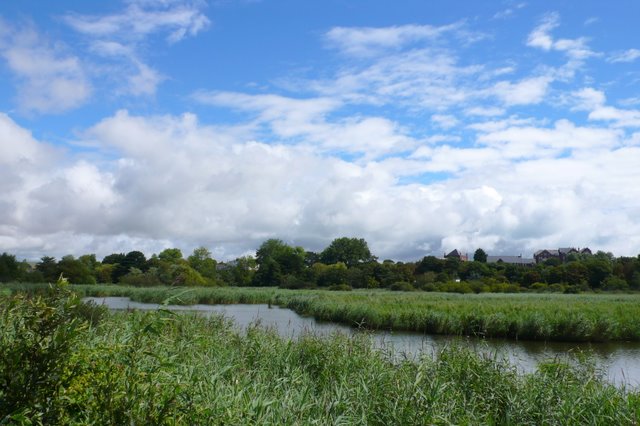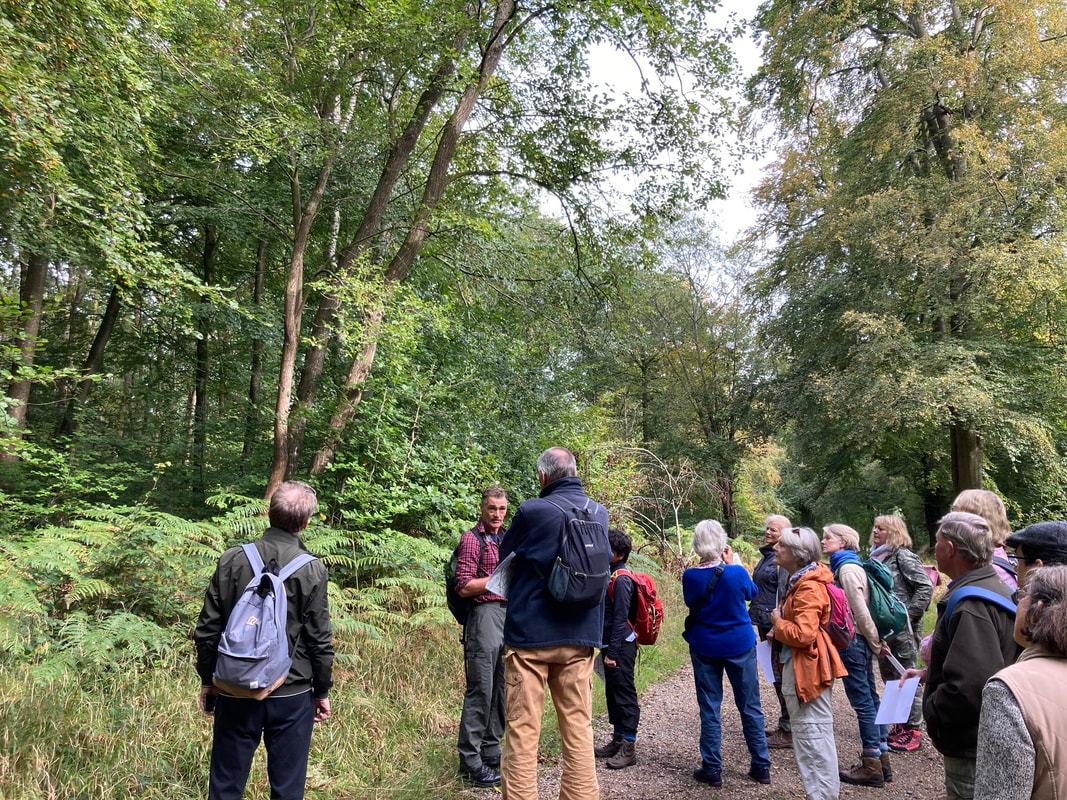|
15 members and friends gathered on the car park at Lodmoor on a bright, sunny but slightly chilly morning. Andrew started out by describing how the marshland of Lodmoor had been designated an SSSI in 1952 but had still suffered from being used as the municipal rubbish dump until the 1970’s. Mercifully, only about a quarter was infilled but this is still evidenced by the vents allowing gases from the landfill to escape – into the car park. Nice.
Lodmoor lies on the east side of Weymouth the earlier parts of which lie on slightly higher ground which separates Lodmoor from Radipole Lake to the west. As the area drains south eastward toward the sea, the freshwater marshes become progressively more brakish until, close to the sea wall and the sluices which control the flow of water between the moor and the sea, it becomes saltmarsh. The flat nature of the area means that reeds, rushes, and other vegetation can obstruct clear views, but we walked along the perimeter paths which gave good visibility out over some of the pools. There were plenty of birds to see including numerous Canada Geese, Lapwings, Teal, Mallard, Shoveller and Gadwall as well as a variety of gull species. The highlight was a flock of around 40 Golden Plover which occasionally got up and flew around together in the sunshine, alternately showing their white undersides and speckled golden upper parts as the swooped around in the blue sky. There were also plenty of Grey Herons as well as several Little Egrets and at least three Great White Egrets. Unfortunately, the Spoonbills which often show up at Lodmoor were not present. These, as well as Egrets, were very unusual birds on Lodmoor 30 years ago but are now relatively commonplace as they colonise the south of the country. There were relatively few wader species to be seen. In addition to about a score of Black Tailed Godwits there were a handful each of Dunlin and Snipe. After being a bit irritating by only showing briefly above the reeds a Marsh Harrier eventually made a decent, very visible flight across the moor. This is another bird, once vanishingly rare in Weymouth which is now resident and breeding and which can usually be seen at Lodmoor and Radipole. After lunch we went over to Radipole Lake which, like Lodmoor, is now managed by the RSPB as a nature reserve. Very different to Lodmoor, visibility is much more restricted by the dense reed beds which make up so much of the reserve. In summer these are full of Reed and Sedge Warblers but throughout the year you can hear the distinctive, and very loud, call of the Cetti’s Warbler. We had our ears peeled for the distinctive call of the Bearded Tit or Bearded Reedling as it is now known (because technically it isn’t a Tit) because this beautiful but elusive bird is more often heard than seen. Unfortunately, we were unlucky although we did hear the unmistakable squealing call of the Water Rail, another rarely seen resident of the reed beds. At the top end of the loop path known as Buddleia Walk, we had views out over the open water where we added Pochard and Tufted to our list of ducks. By the time we dispersed from the car park at Radipole we had seen or heard 40 species of birds, which included Swallow, several of which were flying over on their way south throughout the day. Andrew Graham As an ambassador for Dark Sky International, Steve Tonkin gave us a comprehensive talk on the importance of doing all we can to reduce nocturnal light pollution. Not only does it cause a disruption to the normal life of a wide range of animals, but it is having a long term effect on species numbers. Bright lights at night cause confusion, leading to death on roads, predation by larger animals and fewer opportunities to mate.
We heard examples about robins who get exhausted, mistaking artificial lights for daylight, as they sing through the night and migrating birds who are disoriented by lights and fly into buildings. There are parts of the world where already crops have to be pollinated by hand; for instance, in parts of Canada for their blueberry crops and in parts of China for their apples because insect colonies have vanished. Steve warned that we still have a way to go in further decreasing the light pollution across the AONB, otherwise we risk losing our dark skies designation. The light pollution over Tisbury was a particular concern to see when he showed us the satellite imaging of the AONB. So how can we help? https://darksky.org/ shows the way with guidance on how to assess your own home lighting, particularly in making sure that any outdoor light is appropriately placed with motion sensor activation and downward facing beams in warm not blue tones, to minimise disruption to wildlife. We can also look around our own community to see whether there is unnecessary lighting on public buildings and seek to persuade decision makers to implement changes. Andrew Graham has organised our last trip of the season to these two RSPB reserves in Weymouth. The focus will be on resident and migrant birds. Bring binoculars if you have them. No dogs.
Meet at the Nadder Centre car park at 09:00am or at the Beach car park at Lodmoor DT4 7SX, just to the west of the entrance to the Lodmoor reserve, at approximately 10:30am. Distance, Difficulty and Footwear : The combined distance at these two separate locations will amount to approximately 5 km/3 miles on flat gravel paths which may be a bit muddy after rain. Good stout shoes should suffice rather than wellingtons. Bring a packed lunch and refreshments. There is no limit to numbers on this visit, but it will help if we know how many people to expect. Either use the Contact form here or send us an email to the address mentioned in the members' newsletter.  Steve Tonkin, Dark Sky Advisor to the Cranborne Chase AONB, will be talking to us at our next meeting, at 7:30pm in the Victoria Hall, High Street, Tisbury on Thursday 12 Oct 2023 about Why dark skies matter: the importance to wildlife of responsible lighting. Steve has a life-long passion for astronomy which, of course, has made him aware of the effects of light pollution, and he has been raising the issue with anyone who will listen for the last 30 years. After a first career as a telecommunications engineer, he took a degree in Environmental Studies, did postgraduate work in technology policy, and went on to teach physics, maths and astronomy before retiring to concentrate on astronomy and outreach activities.
Steve supported the Cranborne Chase bid to become a designated International Dark Sky Reserve and his primary task now, as the AONB’s Dark Skies Advisor, is to continue and consolidate the good work that has already been done, and strengthen the AONB Reserve’s standing. The bar opens at 7pm. There's no need to book. Members and those under 21 have free entry. Guests £2 on the door or please contact us for our BACs information as we do prefer online payments. The day was sunny with that slight September chill in the air and we marvelled at the greenness of the trees in Savernake Forest for this time of year. After a wet May and then regular bouts of rain, the trees were showing fewer signs of stress and had kept their leaves longer. Keith Lea had prepared a fascinating day of study and exploration for us as we went off the main paths and visited different sections of the forest.
One of the first tips he shared was the way to differentiate pedunculate from sessile oaks by inspecting the way the leaves and acorns attached to the twigs. Our alliterative aide memoire of sessile-stalk will hopefully stick with us, where the sessile oak has long stalks to its leaves, whereas the pedunculate oak has the leaves forming from barely visible short stalks. We had lively discussions about fungi, having spotted Shaggy parasol, Chicken in the woods, Beefsteak, Earthball and these tiny translucent white parasols perched up high on branches whose name we didn’t know. There were majestic ancient trees to marvel at and glades where trees formed circles round beaten down leaves and mast, or around grassy pastureland in the more open sections. Shifts in the scents of the forest and temperature surges were noticeable as we moved through the different sections. We had a truly immersive day in the life of the forest and Keith was an excellent leader, sharing his knowledge of the trees and wildlife. The end of summer always brings lots of wasps to interrupt our picnics or irritate us in pub gardens. Another member of the wasp family, the Asian Hornet has been in the news lately because of concern about its potential to colonise the UK. It was accidentally introduced into southern France, probably off a container ship, in 2004, since when it has spread rapidly across Europe and towards the Channel.
The Asian Hornet is a very effective predator of insects, including honeybees and other pollinators. It can cause significant losses to bee colonies, and potentially other native species. As one hornet can consume up to 300 bees a day the species could have a devastating impact on our bees if it becomes established. As a result, much effort has gone into publicising the threat and encouraging people to report any sightings. There is even an “Asian Hornet Watch” app to help you to do this. It provides useful photos of the Asian Hornet and other species with which it could be confused. This includes the continent’s only indigenous species, the European Hornet. You can use the app to report a sighting, ideally with a photo. The way to identify an Asian Hornet in three steps is to ask: 1) does is it look mostly black; 2) has it a wide orange stripe on 4th segment of the abdomen (body or “tail”); and 3) do its legs look as if they have been dipped in yellow paint? Taken together these factors clearly separate it from other candidates. Our European Hornet, which has is quite common in the south of England, is a handsome insect slightly larger than the Asian Hornet and about twice the size of a wasp. It has similar markings to the wasp but is chestnut brown and yellow rather than black and yellow. It is not nearly as aggressive as the wasp and will only sting humans if threatened. Indeed, males do not even have a sting. Like other wasps they make paper nests of chewed up wood or bark, often in hollow trees. We may see them foraging in good weather throughout the autumn before the newly mated queens go into hibernation ready to start a new nest in spring. The rest of the colony, including the old queen, dies by winter. You may see the queens stocking up on nectar from flowers prior to hibernation. Since 2016, nationally there have been 52 confirmed sightings of Asian Hornets and 45 nests destroyed. Most sightings have been in Kent and although there have been a few in Dorset and Hampshire, there have been no sightings in Wiltshire yet. It is certainly important to prevent the spread of the Asian Hornet, but we shouldn’t allow our concern to lead us to unnecessarily persecute our native, and largely harmless hornet species. Andrew Graham |
Photo: Avocets (Izzy Fry)
The headers display photos taken by our members. Do get in touch via the Contact Form if you'd like to submit a photo for selection.
Archives
May 2024
Categories
All
|



 RSS Feed
RSS Feed